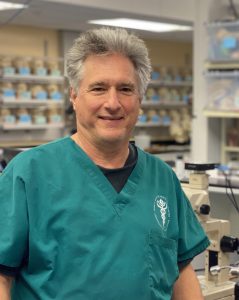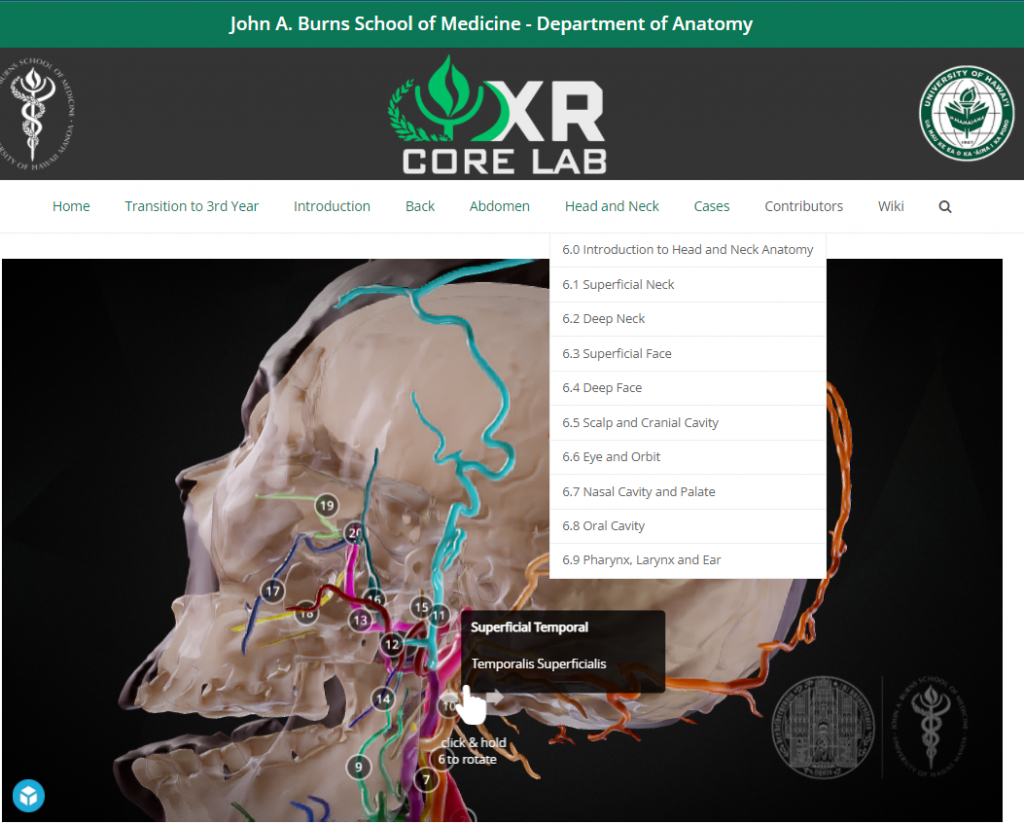
Title: Professor
Department: Medical Curriculum
College/School: JABSOM
Showcase Course: MDED 556 MD6; MED 556L MD6
Email: lozanoff@hawaii.edu
“I am driven to facilitate deep conceptual and practical understanding so that my students effectively acquire the knowledge that is necessary to fulfill their personal commitment of improving the lives of their patients as well as our community.“
Click to read more about Scott’s Teaching Philosophy
My passion for teaching Human Anatomy is twofold. First, I am driven to facilitate deep conceptual and practical understanding so that my students effectively acquire the knowledge that is necessary to fulfill their personal commitment of improving the lives of their patients as well as our community. I strive to achieve this goal by motivating their sense of curiosity and communication as well as their respect and empathy for the donor, themselves and each other. Second, I profoundly appreciate and respect the donations of our altruistic community members whose last and eternal gift to Hawaii are their precious bodies so that medical students can become the caregivers that our community needs. I apply myself to anatomy teaching knowing that our ‘silent teachers’ provide the best possible avenue for learning 3D anatomy and it is their final desire for me, as a JABSOM faculty member, to utilize their gift to the best and fullest intellectual and practical advantage for training our medical students.
Online presentation of Human Gross Anatomy
Teaching Practice
expand/collapse
Human Gross Anatomy is a required class in the John A. Burns School of Medicine (JABSOM) for first-year students and second-year students (n=156) because: A) a deep, 3D understanding of the human body is required to conduct the physical exam, perform diagnostic procedures and therapeutic interventions; and, B) students must pass the discipline of Anatomy on Part I of the boards or they do not proceed in their training or receive a license to practice medicine in which case the investment that both JABSOM and the State of Hawaii makes to train physicians to care for our community is lost.
Traditionally, anatomy is taught through large-group face-to-face (F2F) didactic lectures following by laboratories where small groups of students interact to dissect the human body in a regional sequence through meticulous and respectful interactions. At JABSOM, the Head and Neck portion of the program is conducted as a separate course in the period that is roughly equivalent to the fall semester at UH Manoa. The course comprises 30 hours of F2F contact hours (lecture + lab). However, small group sessions during evenings and weekends easily triple the amount of contact time and are not tracked as faculty contact time since they are at student request.
The course relies on generous and altruistic donations from our community to JABSOM’s Willed Body Program. Dissection is an integral component of the learning process since anatomy education is aimed at enabling students to comprehend 3D spatial relationships that cannot be conveyed through simple 2D book pictures. Contact with the donor’s body is likely the students’ first direct experience with death and evokes and fosters a sense of empathy and compassion, two important qualities for all physicians.
Covid changed everything. In March of 2020, F2F classes were stopped and anatomy moved from the Gross Anatomy lab to online teaching that initially consisted of giving synchronous PowerPoint lectures over Zoom. This transition demonstrated the challenges associated with attempting to portray 3D spatial relationships in anatomy through 2D pictures online. It did not work whatsoever based on end-of-unit student survey. The definition, design, and delivery of anatomy instruction had to change, yet the core educational relationship between the student and body donor had to be retained.
A learning system was designed to provide an online learning experience that emphasized cadaver anatomy exploration as well as asynchronous & online instruction that included: 1) posting Anatomy Faculty PowerPoint decks; 2) Pre-recorded lectures (youtube) for asynchronous review; 3) online streaming presentation of JABSOM cadaveric dissection; 4) creation of online 3D anatomical models to understand spatial relationships; 5) development and application of an online DICOM viewing platform (Rad3d.com) for case based delivery of JABSOM cadavers; 6) perform limited anatomical dissection by dividing the class so that social distancing was achieved and requiring universal precautions were executed (scrubs, PPE including masks, face shield, gloves, directional entry and exit of the lab and anatomy corridor); 7) survey students to understand strengths and weaknesses of the approach.
A workflow was developed to: 1) Transported cadavers to Queen’s for MRI and returned to the JABSOM Gross Anatomy lab; 2) load MR scans to Rad3d.com viewer platform; 3) Write case reports by JABSOM clinicians and uploaded to Rad3d; 4) create online 3D anatomy models through an Academy Creative Media, UH Manoa internship developed for this purpose; 5) live stream hybrid labs directly from JABSOM and broadcast through a secure system as a replacement for F2F lectures.
To facilitate limited lab experiences, a website was developed that enabled students to prepare for each lab prior to the scheduled session. The approach benefited from the prior development of the Rad3d.com platform as a XRL8/UH Ventures spinout. The platform was developed for Virtual Reality Radiology applications, but was re-tooled specifically for this JABSOM instructional purpose. We are currently examining various Virtual Reality tools as learning module devices for delivery of Gross Anatomy education in anticipation of WebVR. It is noted that this program was implemented at no expense to the students.
The educational outcomes of this new approach were assessed by comparing final exam scores from 2020 with two earlier years (2018, 2019) as well as conducting an extensive student perception survey. Quantitative Assessment revealed Final Exam scores improved with hybrid labs: 2018 (x=84.1,sd=8.2), 2019 (x=83.1,sd=8.5), 2020 (x=90.9,sd=8.5). Semi-Quantitative/Qualitative assessment (survey 72 prompts; 78 responses; Likert scale; two-tailed; P < 0.05) showed that: 1) Anatomy Dissection was useful/very useful (87%) and thus will be retained Post-Covid; 2) 88% believed that anatomical spatial relationships were retained in the online labs and that hybrid labs were useful/very useful (95%) indicating that the technology works; 3) There will be continued development of the Rad3d platform since 75% of the students were satisfied with using the JABSOM anatomy resources; 4) F2F lectures were not preferred (14%) while pre-recorded lectures were preferred (47%) and online hybrid labs (95% found useful/very useful; and 82% most/more preferred hybrid labs) will be presented in lieu of F2F lectures in MD6, 2021.Impact
expand/collapse
Specific impacts (in addition to paragraph 8, previous section):
- Dept. of Ob/Gyn, JABSOM, will use this delivery system for anatomy instruction for 3rd year clinical transition.
- Collaborative case-based gross anatomy collaboration with Dr. G. Aytac (TOBB Univ, Ankara, Turkey to JABSOM and Turkish medical students received a 1st place presentation award at an international anatomy education meeting.
- Provided UH students with opportunities to engage in educational research with positive outcome: Nicole Nakamatsu, 2nd year medical student, presented this teaching program at HPEC (2020) and Biomedical Sciences Symposium (2021) at UH and received 1st place presentation awards at both meetings; Brandi Mikami, 3rd Year Pre-med undergraduate (UH, Manoa) presented a conjoined twin case presentation using this system and received 3rd place INBRE poster award (2021).
- Dept of KRS, UH Manoa is using components of this teaching system for KRS 603 & KRS 604.
- Four UH Manoa ACM students completed the new ACM-JABSOM Internship (in conjunction with Brittany Biggs, ACM) to create 3D anatomy models with more students enrolled in the fall. This is a unique opportunity since ACM students obtain experience using z-brush and posting with sketchfab.
- KCC (Dr. Amanda Lee, Zool 141, 142) and UHWO (Dr. Becca Romine, Zool 141, 142) are adapting components of this teaching system for their undergraduate courses.
- A library of 3D models is now available for students.
- Dissection videos are now available (not shown here due to sensitivity & privacy).
Supplemental Material
- Demonstration video
- Assignment website (XRCore Lab) (with Syllabus):

